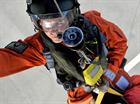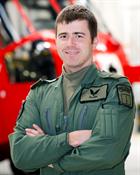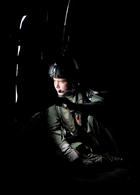Culdrose hero honoured at Sun Military Awards, The Millies
The excellent work of the Armed Forces and the people who support them was recognised last night at the fifth annual Sun Military Awards (The Millies), organised by The Sun newspaper in close collaboration with the Ministry of Defence.
Their Royal Highnesses The Prince of Wales and The Duchess of Cornwall were guests of honour at the event – billed as “A Night of Heroes” – held at the Imperial War Museum, London, on Thursday 6 December. They were joined by the Prime Minister and Mrs Cameron, Defence Ministers and Military Chiefs, senior government and political figures, and stars from the worlds of entertainment and sport to pay tribute to these exceptional individuals.
The awards celebrated across nine categories the professionalism and bravery of the men and women working in our Armed Forces around the world. Also recognised were members of the public who in various ways work tirelessly to support our Service personnel.
Among those presented with an award was Cpl Justin Morgan of 771 Naval Air Squadron based at Royal Naval Air Station Culdrose, Helston, Cornwall who won the Outstanding Sailor/Marine of the Year category. Speaking after the ceremony, he said:
“I am so very pleased to receive this award as recognition of the work that we at 771 Naval Air Squadron provide day in, day out and to my fellow aircrew, engineers and all the support staff. It was truly a team effort and we couldn’t have done without them. It has been fantastic to actually meet the yachtsman we rescued, catch up on what happened and provide some closure to the event.”
Admiral Sir Mark Stanhope, First Sea Lord said:
“Over the last five years, the Sun Military Awards has shone the spotlight on the courage, tenacity and professionalism of our Armed Forces. This year has been no exception, showcasing these outstanding men and women, serving the nation’s interests both across the world on operations, and in the UK.”
The ceremony, including unique footage of shortlisted individuals and teams at work, plus reconstructions of the acts of heroism that were nominated, will be televised on Friday 14 December at 9pm, on ITV1.
RESCUE 193
Lieutenant Commander A Jones Royal Navy – Search and Rescue Aircraft Commander, 1st Pilot, Left-Hand Seat Pilot
Lieutenant Commander A Knight Royal Navy – 2nd Pilot, Right-Hand Seat Pilot
Lieutenant Commander M Ford Royal Navy – Observer
Corporal J Morgan Royal Marines - Winchman
At 1945L on Wednesday 15 August 2012, “Rescue 193”, the 771 Naval Air Squadron Search and Rescue (SAR) helicopter was scrambled following the detected activation of a SAR Beacon from the 6m single-handed French yacht “RAOUL PASTERQUE”, 50nm North West of St Ives, Cornwall. Weather conditions were extreme with 40 knot winds, sea state 8 and a 40ft swell. Following an initial planning estimate, additional fuel was taken prior to departure in order to maximize the duration of the search. At this stage, the only information available was the satellite ascertained position of the SAR beacon updated by Falmouth CG, so with only an hour of daylight remaining the aircraft transited at height, in turbulent cumulus cloud, in an effort to ‘home in’ on the distress frequency. Homing to the distress beacon was not possible and the beacon signal could only be heard sporadically through the aircraft radio, but unusually there was no indication to the pilots as to what bearing the signal was coming from. After re-checking equipment and unsuccessfully testing secondary methods of homing, the crew initially suspected that the sea state was limiting the range of the beacon signal at low level. Radar was also ineffective due to the sea state and wave size. Having now arrived at the datum position given by Falmouth Maritime Rescue Co-ordination Centre (MRCC) a square search was conducted whilst timely sitreps were passed to the Coast Guard and the Aeronautical Rescue Co-ordination Centre. As further SARBE satellite ‘hits’ were received by the MRCC, their positions were plotted and visual searches were modified accordingly. Unable to locate the small yacht, the difficulty of the rescue was further compounded by frequent heavy showers and the onset of darkness. Despite the unserviceable onboard homing equipment, FORD began making an attempt to remedy the deteriorating situation by triangulating a likely position of the “RAOUL PASTERQUE” using the SARBE audio volume alone as an indication of the yacht’s likely bearing from the aircraft. This non-standard SAR procedure involved plotting bearing lines taken from the compass heading whenever the audio of the beacon was at its loudest. With a bearing line plotted, the aircraft was offset laterally to generate a cross-cut and further assessments made of the probable bearing of the beacon. A succession of these events allowed the crew to produce a fix as to the likely datum position of the “RAOUL PASTERQUE.”
The crew donned Night Vision Goggles and continued the visual search in darkness. Mindful of the ongoing search and unknown medical condition of the solo yachtsman, as well as the appalling weather, darkness and unserviceable homing equipment, FORD updated the Aeronautical Rescue Co-ordination Centre and suggested they prepare to launch other assets to assist the search. Then, whilst flying a search pattern in the vicinity of the datum, a flare was sighted by the crew and an expeditious approach made to the vicinity of the yacht. MORGAN dropped a flame float as a further visual reference and KNIGHT positioned the aircraft so a crew recce could be conducted. The yacht was found lying beam on to the sea, not making any way, with both sails, wreckage and some flotsam in the water, and appeared to be without any steerage or means of control. As the aircraft hovered alongside, a particularly heavy squall passed through. KNIGHT hovered using only the white landing light as a means of illuminating the yacht for a visual reference, whilst responding to the conn of MORGAN as the visibility reduced to 100m in the torrential rain. One survivor could be seen aft, wearing a survival suit, but communications of any form could not be established due to the poor visibility and lack of response from the yacht to any radio calls. It was assessed that a rescue could not safely be effected until the squall passed through and although maintaining a hover in these conditions was extremely challenging, the crew did not want to orbit the yacht as, if visual contact was lost it was believed that it would be very difficult to reacquire the vessel again. As the squall blew through, FORD ascertained that there were no other vessels within an hours’ steaming of their position that might be used to shelter the yacht and assist with recovery. The crew decided that despite the conditions, a winch rescue was the best option. FORD took control of the aircraft from the rear door position using Auxiliary Hover Trim and with great skill and tenacity manoeuvred the aircraft safely over the top of the yacht in order to pass a hi-line to the yachtsman. The plan was to then send MORGAN down to the yacht and use the routine hi-line technique to recover the sailor. Unexpectedly however, once the yachtsman had the hi-line in hand, he tied it around his waist and abandoned his vessel, jumping straight into the pitching sea. The crew acted quickly and calmly to this dramatic event. With the aircraft still under Auxiliary Hover Trim control overhead the pitching yacht, and with the casualty now attached to the aircraft via the hi-line there was significant risk that under tension the line would break. Without hesitation MORGAN readied himself in the door and FORD then lowered him into the sea, clear of the “RAOUL PASTERQUE” and the wreckage that was floating around her. As the sailor drifted clear of his yacht, MORGAN pulled the casualty towards himself using sheer brute force, whilst KNIGHT moved the aircraft towards the casualty’s position under FORD’s verbal direction and with only his instruments to guide him. Due to the huge swell, ferocious spray and constant buffeting MORGAN elected to inflate his lifejacket to keep himself on the surface whilst he dragged the sailor towards him. At this point he could not see the survivor because of the sea state, but knew because of the tension in the line that he was on the end of the hi-line. Once MORGAN had physically taken hold of the survivor he placed him into the strop and cut away obstruction, FORD winched them both into the aircraft together. After 40 minutes hovering over the yacht the rescue had been effected safely and the aircraft then proceeded to the Royal Cornwall Hospital, where the yachtsman received treatment for his injuries.
The crew of “Rescue 193” acted commendably as a team throughout this testing rescue. KNIGHT handled the aircraft commendably in the most challenging of environmental conditions, often with minimal visual references, over a 40ft pitching sea. As aircraft commander, JONES was able to calmly lead the rescue and oversee the responsibilities of the entire crew during this highly demanding rescue, whilst also monitoring aircraft systems, fuel and navigation. FORD’s ability to think laterally when searching the datum, his calm demeanour and skills in the air allowed him to physically control the rescue safely, even when reacting to the unforeseen event of the sailor abandoning his yacht. MORGAN was cool headed and fearless, displaying extreme determination and fitness in heavy seas in order to rescue a desperate sailor.
This rescue was completed in the most demanding of conditions using the highest standards of crew co-operation, flexibility and determination. A injured mariner in imminent danger was safely recovered from his badly damaged yacht in the most appalling conditions.



